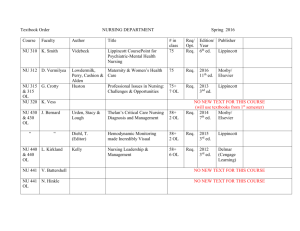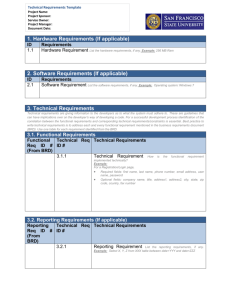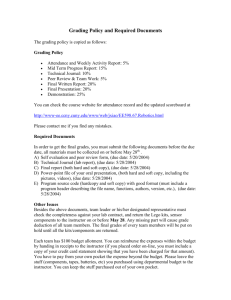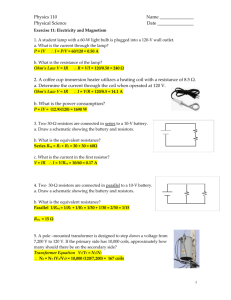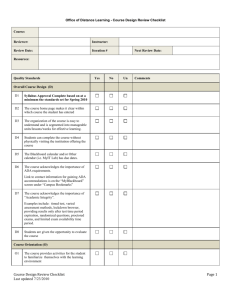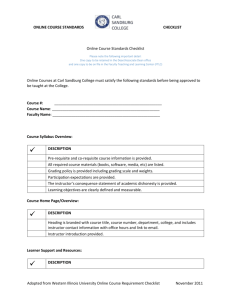Quality Course Design Checklist - Lorain County Community College
advertisement
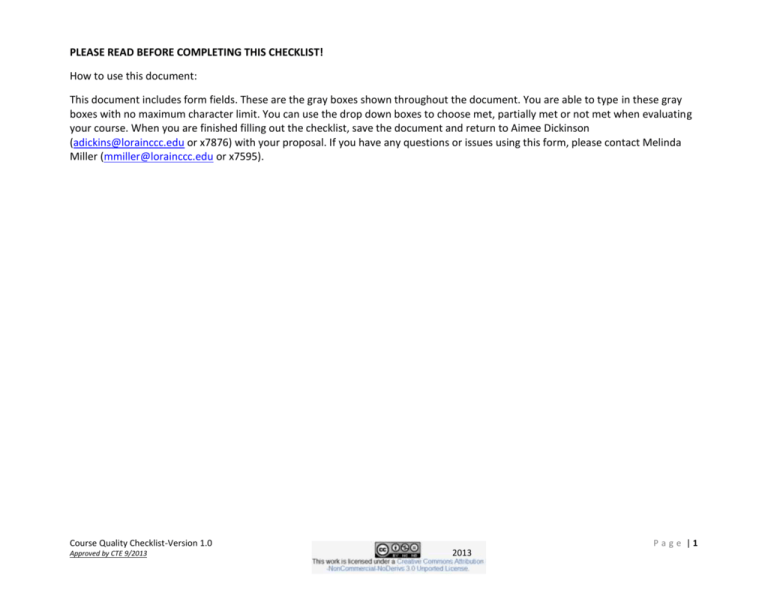
PLEASE READ BEFORE COMPLETING THIS CHECKLIST! How to use this document: This document includes form fields. These are the gray boxes shown throughout the document. You are able to type in these gray boxes with no maximum character limit. You can use the drop down boxes to choose met, partially met or not met when evaluating your course. When you are finished filling out the checklist, save the document and return to Aimee Dickinson (adickins@lorainccc.edu or x7876) with your proposal. If you have any questions or issues using this form, please contact Melinda Miller (mmiller@lorainccc.edu or x7595). Course Quality Checklist-Version 1.0 Approved by CTE 9/2013 P a g e |1 2013 LCCC Course Quality Checklist Use of Checklist for self-assessment of course design and/or course construction: The LCCC Quality Checklist has been created help to identify gaps in course development and design that should be addressed to enhance course quality and improve the student experience in online and blended courses. A faculty developer can use this document as a checklist/self-evaluation tool to ensure that the important pedagogical features of an online or blended course are present and addressed in his/her course. A more detailed description of the expectations for each criterion can be found in the LCCC Annotated Quality Checklist and additional training information about how to accomplish these expectations can be found in the Course Development using ANGEL 8.0 - A Self-Paced Faculty Training Course found in ANGEL. Use of Checklist by peer review team to do a more formal evaluation quality of an online or blended course: - Column 1 displays the listing of the specific quality criteria. The checkboxes found with some of the criteria provide “quick check” suggestions that would indicate that course is meeting the expected standards for the criterion, along with information about “how much is enough”. Click on items that are present in the course to help you determine if the course has met that criterion. - Column 2 (Value) represents the weighted value of each of the criteria. Some criteria are more critical than others for quality design: Required (REQ): 20 criteria o This element MUST be present in the course because a student would need this to effectively interact with the course. o A course would not be considered for Excellence Recognition if this criterion were not MET. Very Important (VI): 15 criteria o A good quality course would be expected to have such an element because this is a feature that would likely improve student interaction with the course. o A course would not be considered for Excellence Recognition if this criterion were not MET or PARTIALLY MET. Important (I): 3 criteria o A good quality course would likely have such an element but it is not essential to the running of the course or student interaction with the course. o Although this would be a best practice, a course would be able to receive Excellence Recognition even if this element were missing. - Column 3 (Rating) is defined as follows: Rating of MET (2): The course reflects a minimum of 85% of the expected standards/expectations for the specific criterion. Rating of PARTIALLY MET (1): The course reflects 70-84% of the expected standards/expectations for the specific criterion. Rating of NOT MET (0): The course addresses <70% of the expected standards/expectations for the specific criterion. Feedback and Guidance Comments: This section should be used to identify areas where the faculty developer has excelled or employed innovative ideas and/or to provide suggestions and guidance for helping the course to meet the expected standards. - Column 4 represents a space for feedback to the instructor, which could include things that are well done or suggestions for improvement. Course Quality Checklist-Version 1.0 Approved by CTE 9/2013 P a g e |2 2013 LCCC Course Quality Checklist Course Number and Title: Specific Criteria Category 1: Introduction/ Getting Started 1.1 Provide a welcome message on course homepage to make it clear how to get to a “start here” or “orientation” document, page, or video for the course 1.2 Provide a “start here” or “orientation” document describing an overview of the course layout and the location/purpose of course components. Organizational structure of Also needed for Blended course is described course: Description of course elements Explain what “blended” means Purpose of each item in List of what material is learning covered face-to-face and Marking of optional what will be found online assignment Indication of when/where face-to-face List of technology meetings take place requirements Value Course Instructor: Enter Number: Feedback and Guidance Comments 2 (Met), 1 (Partially Met), 0 (Not Met) REQ Met 2 REQ Met 2 VI Met 2 VI Met 2 Tips for being a successful online student (optional) 1.3 Introductions: 1.3a Provide an online, written or video self-introduction 1.3b Provide a forum for required student self-introduction Course Quality Checklist-Version 1.0 Approved by CTE 9/2013 P a g e |3 2013 Course Number and Title: Specific Criteria 1.4 Syllabus: 1.4a Direct students to information about technical support services, student support services, and general college policies. (either option) Link or written explanation provided for universal course information Instructor-provided policy information 1.4b Provide instructor contact information Instructor name Email, phone number and indication of preferred contact method Office hours Response time for email/phone 1.4c Provide course information Course title Course prerequisites Semester and length of semester Technical requirements (computer and user) General academic requirements Textbook and/or other materials 1.4d List specific instructor policies for the course Expected communication netiquette Academic integrity expectations Attendance and interaction Late/make-up assignment policy 1.4e Describe a grading policy that is clear and understandable List of assignments Points and % each counts towards course grade List of grading guidelines and criteria Total points and overall grading scale REQ Course Instructor: Enter Number: Feedback and Guidance Comments 2 (Met), 1 (Partially Met), 0 (Not Met) Met 2 REQ Met 2 REQ Met 2 REQ Met 2 REQ Met 2 Value Course Quality Checklist-Version 1.0 Approved by CTE 9/2013 P a g e |4 2013 Course Number and Title: Specific Criteria 1.5 Include a concise, detailed course schedule delineating required course activities and due dates is present in the course. List of all course assignments, activities, and due dates available in a printer-friendly format Identify where each activity/assignment will be found or take place List time of use for each course element (when available, can student work ahead?) Post important dates into the ANGEL calendar and/or use milestones Category 2: Organizational Design/ Navigation/ Findability 2.1 Provide links for accessing software and plug-ins that may be needed for accessing course elements 2.2 Course material: 2.2a Logically arrange course materials into appropriate organizational folders or lesson plan pages, and folders or lesson plan pages are sensibly arranged in the course 2.2b Use consistent structural format/design of folders or web pages 2.2c Utilize appropriate, identifying titles and descriptive subtitles 2.2d Present content in platform-free and reasonably sized, downloadable format 2.2e Use documents that contain Titles and Headers to break up the information into manageable “chunks” of information 2.2f Use course links (provided by the instructor) that send the user to the appropriate and functional websites, video, and audio elements, and internal course documents Value REQ I Course Instructor: Enter Number: Feedback and Guidance Comments 2 (Met), 1 (Partially Met), 0 (Not Met) Met 2 Met 2 REQ Met 2 REQ Met 2 VI Met 2 VI Met 2 VI Met 2 REQ Met 2 Course Quality Checklist-Version 1.0 Approved by CTE 9/2013 P a g e |5 2013 Course Number and Title: Specific Criteria 2.3 Navigation through the course materials: 2.3a Be logical, predictable, and efficient Minimize subfolder usage Minimize scrolling Use reasonable # of items on page Use intuitive design so student knows what to do “next” 2.3b Provide the student with easy to locate course components and information 2.4 Format content consistently throughout the course and provide effective viewing for readability and navigational purposes. Uses consistent font, font size, font color, and contrast Minimizes “moving” elements Uses tables or columns to organize certain materials, where appropriate Documents are mostly free of spelling and grammar errors 2.5 Assignments/tasks: 2.5a Distribute assignments/tasks equally throughout the semester to ensure appropriate course pacing 2.5b Have clear parameters and complete instructions 2.6 Allow student to access to up-to-date, timely feedback about his/her progress in the course throughout the semester Use of ANGEL gradebook Reasonable response time to communications (within 24 hours) Return of graded assignments within a reasonable time period (within 1 week) Category 3: Learning Outcomes/ Objectives Value VI Course Instructor: Enter Number: Feedback and Guidance Comments 2 (Met), 1 (Partially Met), 0 (Not Met) Met 2 REQ Met 2 VI Met 2 VI Met 2 VI REQ Met 2 Met 2 Course Quality Checklist-Version 1.0 Approved by CTE 9/2013 P a g e |6 2013 Course Number and Title: Specific Criteria VI Met 2 VI Met 2 REQ Met 2 REQ Met 2 REQ Met 2 REQ Met 2 Value 3.1 List course and general education learning outcomes on the course syllabus 3.2 Organize course content into identifiable units that align with the course outcomes/ objectives. Compartmentalized units are present Units align with course objectives 3.3 Include learning objectives in each unit that are specific and measurable and align to the course outcomes Measurable unit objectives are present in each course unit Unit learning objectives align with course outcomes Category 4: Assessments 4.1 Align assessments with course and unit objectives, course content and activities 4.2 Clearly define expectations and due dates Provide complete directions for each assignment Identify due dates for each assignment 4.3 Use a variety of formative and summative assessments to assess student learning (Should include 3 or more of the following assessment types) Discussions Quizzes Tests Papers/journals VI Course Instructor: Enter Number: Feedback and Guidance Comments 2 (Met), 1 (Partially Met), 0 (Not Met) Met 2 Projects Surveys Other______________ 4.4 Provide grading criteria for all graded assignments. Explanation of grading criteria is included in syllabus or with assignment instructions Rubrics are provided for grading of written work Course Quality Checklist-Version 1.0 Approved by CTE 9/2013 P a g e |7 2013 Course Number and Title: Specific Criteria 4.5 Allow students the opportunity to take low-stakes quizzes, self-check activities or practice tests or assignments Category 5: Course Material, Interaction, and Engagement 5.1 Align learning activities and course materials with course learning objectives Value I Course Instructor: Enter Number: Feedback and Guidance Comments 2 (Met), 1 (Partially Met), 0 (Not Met) Met 2 REQ Met 2 5.2 Explain the relationships between course objectives, course materials, and learning activities I Met 2 5.3 Vary the course content and learning activities to meet the needs of a diverse student audience Textual Visual with alternative text for images/graphics Kinesthetic Auditory with closed captioning or accompanying written transcript 5.4 Properly cite materials and resources VI Met 2 REQ Met 2 REQ Met 2 5.5 Promote active learning through course content (Should include 4 or more of the following types of activities) Reading assignment Discussion/debate Video/animation/ Project simulation Learning games Audio clip Website searches Lab experiment Practice problems or Online homework quizzes Case study evaluation Researching topics Writing assignment Other______________ Course Quality Checklist-Version 1.0 Approved by CTE 9/2013 P a g e |8 2013 Course Number and Title: Specific Criteria Value 5.6 Promote frequent and meaningful learning activities and interactions with the instructor, course content, and other students Student-instructor Student-content Student-student 5.7 State expectations for individual, small group and whole class interaction Frequency/quality expectations Netiquette standards Grading criteria General Comments Please include any other comments that have not been previously addressed VI REQ Course Instructor: Enter Number: Feedback and Guidance Comments 2 (Met), 1 (Partially Met), 0 (Not Met) Met 2 Met 2 LCCC Course Quality Checklist Review information Course Number and Title: Course Instructor name: Peer Reviewer name: Date of Review: Course Quality Checklist-Version 1.0 Approved by CTE 9/2013 P a g e |9 2013
